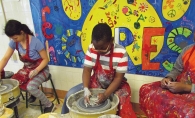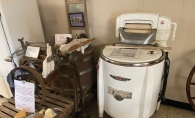Junior and senior students from the Osseo Senior High Health Science Magnet visited Boston Scientific, a bio-medical tech company, last September. They had fun, learned about scientific manufacturing, and were surprised by things they were told.
Freshmen through seniors who are interested in any part of the medical field can become involved in the magnet program any time during the year. Students cover biology and chemistry, but with an emphasis on, and using the tools of, the medical professions.
The program has three tracks: emergency medical services, nursing and general medicine. It also offers clinical experience at nursing homes. By the time graduation rolls around, students can become a certified EMT or a licensed nurse assistant. The career skills they learn are meant to ease navigation through their chosen field.
The recent trip to Boston Scientific gave students a chance to see other possibilities in the field, opening their eyes to the tech industry that supports medicine. People working at Boston Scientific have a variety of academic degrees. Some are nurses and doctors, others are assemblers. The visit exposed students to a medical facilities beyond what they were familiar with, namely the doctor’s office or the hospital.
The Trip
Upon arriving at Boston Scientific, the students were asked, “What do you think medical manufacturing is?” They were unsure. They hadn’t heard of it. But one student got it right when he answered, “Making devices that can save lives and heal diseases.”
As the students toured the facility, “they interacted, they asked questions. They fully participated. They were awesome,” says Megan Barnett-Livgard, business retention and expansion manager at Boston Scientific.
This was a hands-on trip. In the anatomical modeling lab, the students wore 3D glasses and handled 3D models of human organs. Using a stylus they could pull the models apart to examine different aspects of the organs.
In the 3D printing lab, they saw printed organs made of various materials which are used to test new products and aide specialists in solving problems for individual hearts and deciding the best course of action.
In the wet lab, students interacted with a variety of stents and catheters made of different materials. They experimented with a 3D heart that was pumping water, placing the stent within it to allow for better flow just as doctors do with patients.
“When students got the stent working right,” health science magnet co-ordinator Elie Bengston says, “It was great to hear an employee say, ‘Hey, you’ve saved a life.’”
After the tour they had lunch. Four employees, including a doctor, nurse and engineer, explained how they got into the field, sharing their professional passion. They encouraged students to continue to learn all they could, stay in school and do their homework, and, if possible, to shadow someone in the industry.
The Surprise
Before the tour students were asked, “How much do you think someone working in medical manufacturing makes per year?” They guessed $40,000, then $60-$80,000, then, with a doubtful tone, $70,00-$90,000. They were stunned when told the average income was $103,700. As that thought settled in, students became very happy. “It looks like a fun job to work at fulltime if you had the chance,” one remarked, and another said, “I think it’s time to re-think my plans.”
Hometown student excitement about jobs in the medical field can be nothing but good for the future of Maple Grove.
Students React
“The tour of Boston Scientific was an awesome hands-on experience. We got to see the 3D-4D software program that allowed us to literally pull apart pieces of the human body right in front of our faces. You could pull parts of the body, like the arteries in the heart and examine them ever closer, peeling back layers, separating them out. We also had a chance to place stents in 3D printed arteries of the heart. It was so cool being able to try it and get an idea of just how hard it could be if doing it on a real person.”—Joe Moraczewski, Osseo OEC intern
I never actually knew what went on inside Boston Scientific. I assumed it was like a modified factory for making medical devices. I was surprised to walk into a building that was completely filled with offices and work spaces.
First, we walked into the 3D computer lab where we got to see body parts in 3D. It looked as if they were floating in air. With the help of 3D glasses we got to visualize details of the body that normally would be hard to picture on paper.
I got a sense of what it was like to be an employee at Boston Scientific. I got a clue as the how important their work really is.”—Christine Chukwuocha, Osseo OEC intern









